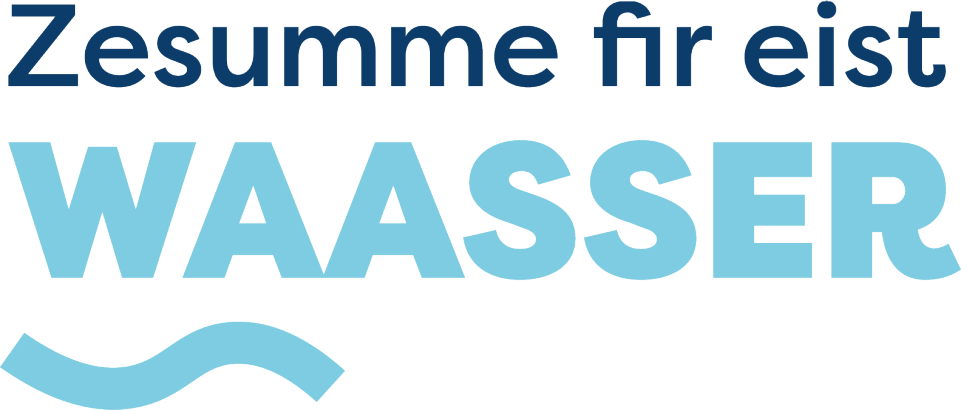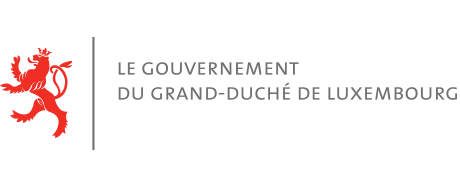About The Project
The increasingly rapid changes in technology, economy, and society make it difficult to predict and model the future. Basic natural resources such as water and land are becoming increasingly strained due to economic and population growth, particularly in the small but rapidly growing country of Luxembourg. While some future changes are relatively predictable, others remain uncertain.
However, one thing is certain: many future impacts of global change can be influenced by human actions, both for better or for worse. The need for new methods of decision-making in the face of such complex connections is clear.
Let's shape the future together! Join the movement to create a sustainable and thriving future by actively participating in decision-making processes. With our collective actions, we can make a positive impact and ensure a better tomorrow.
Regenerative initiatives should take account of complex interdependencies between changes across social and environmental spheres, and across a wider range of spatial and temporal scales (Garmestani et al., 2020). Actions and experimentation will thus benefit from being networked across a range of spatial and temporal scales and levels of governance; at the same time, they should take account of changes in different place-based circumstances and human needs and wants in diverse local groups.
Accordingly, the citizen science work strand is concerned with the interplay of science, policy and practice for the protection and regeneration of surface water bodies. The decline of water quality is conceived as emergent phenomenon in complex social-ecological-technological systems. Our research approach, ‘transformative sustainability science’, relies on participatory processes to combine scientific knowledge and expertise from the natural and social sciences with place-based knowledge and experiences (König, 2018). We develop concepts, methods, processes, and spaces for participatory scientific inquiry such that they can embrace complexity, contingency, uncertainty and contradictions between diverse experts and interest groups. Citizen science, defined as a process of scientific inquiry to which volunteers contribute as well as expert scientists, presents a promising approach to engage diverse groups across different places, governance levels and across time, in collaborative processes to better understand and enhance our action repertoire to reverse environmental degradation, including declining water quality. The project responds to calls for greater citizen participation in water governance of the EU water framework directive, the CSDD expert opinion on sustainable water governance, as well as Vision 2020 of the European Statistical System for the generation of data and statistics from more diversified sources.
This part of the project presented my team with a first opportunity to engage in developing citizen science approaches for Luxembourg, and beyond. We could engage an internationally leading scientist Prof. Muki Haklay from the University College London as a member of the Committee d’Encadrement de Thèse of the doctoral researcher, and in capacity building efforts in environmental citizen science in Luxembourg. Karl Pickar successfully defended his Dissertation on 16.12.2021, accepted a job as manager in the ‘Natur Park Our’ in January 2022, with a continued interest in citizen science and collaboration. The final revised version of the Ph.D. Dissertation is to be submitted in due course.
The research project served to explore the potential of citizen science as a non-traditional source of data to complement the current data production process for evidence-based policymaking. Conceptual frameworks helped to explore the official data production process in relation to different purposes of environmental policies. These frameworks highlight different challenges that the current official data production process sees itself confronted with in relation to the different purposes of the policies and associated monitoring regimes. The empirical evidence from interviews, workshops and public data collection campaigns demonstrates that citizen science can meaningfully contribute both to the evidence base for policy and practice, as well as to an improved governance process.
Citizen science can be practiced in different ways that attribute different roles in the scientific inquiry process to scientific experts and non-expert citizen volunteers (Figure 2.1). The role of volunteers ranges from mere crowd sourcing of data points in contributory approaches to the co-creation of data sets and social processes for their analysis and interpretation in which citizen science stakeholders jointly define the purpose, research questions, and co-design the citizen science tool sets.

The project served to co-design a citizen science approach with tools including a detection kit, sets of indicators for different types of water bodies, a prototype mobile application with decision trees to determine data input possibilities (e.g., sets of site-specific or behavioural data including photos and other observations), which respond to quality criteria from diverse stakeholders and citizen volunteers for the co-creation of actionable knowledge. The co-design process engaged stakeholders from relevant administrations, municipalities, a nature parc and environmental NGOs in four workshops; engaged organisations are interested in continuing collaboration to deploy the tool once it is launched. The process helped to better understand and compare quality and design criteria for tools, processes, and spaces (virtual, institutional, social) for citizen science by diverse stakeholders including experts and lay persons, in diverse settings. The programming of the corresponding API and data base is expected to be completed by July 2022. Figure 2 depicts the data structure of the resulting citizen science tool kit.
These activities helped establish a network of engaged organisations for further work on citizen science and the decentralization of environmental governance. Working with these experts in turn also helps to legitimate to our findings and methods, and to increase chances that they gain traction in practice. Last but not least, partnerships with public bodies and active involvement in advisory committees, and our interactive research style aiming at dialogic learning by all engaged in interviews and workshops, contribute to capacity building relating to citizen science for decentralized or ‘polycentric’ water governance in practice with professionals.
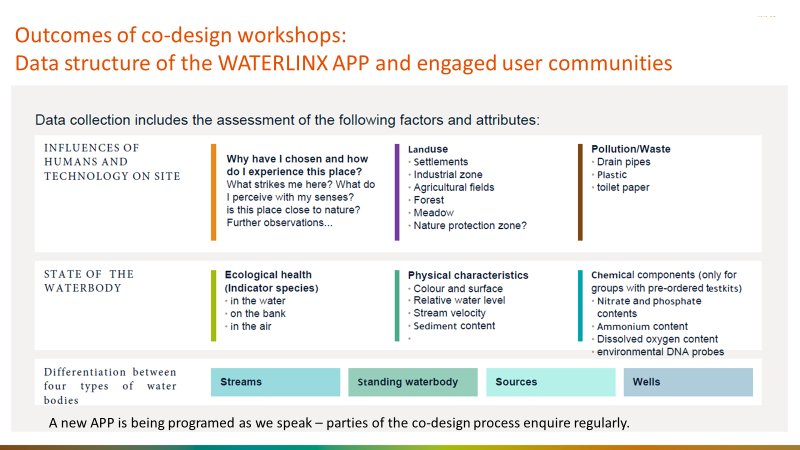
The co-design process resulted in unique sets of indicators that are deemed appropriate for citizen science for adaptive governance in Luxembourg (see e.g. the WATGOV Working Paper 1 by Pickar & König, 2020). From this co-design process we learnt that our initial focus on indicators such as nutrient levels was of interest (nitrate and phosphate content, high levels of which cause eutrophication, a process that undermines species diversity in aquatic habitats). The collaboration with Prof. Jo Hansen at the FSTC allowed to refine some of the indicators on physico-chemical properties (e.g., dissolved oxygen and ammonia levels in surface water) that are suitable for use in citizen science. However, in response to suggestions at the workshops, the original plan to develop a test kit for pathogenic bacteria was replaced with the development of a set of indicator species for the state of health of diverse types of aquatic ecosystems. This part of the project involved close collaboration with Luxemburg’s experts on aquatic ecosystems in different types for water bodies from the water management administration (AGE), the nature and forest administration (ANF) and the NGO Natur & Emwelt, this work was mainly carried out by Lena Hirschler, a Master Student in Biology at the University of Trier (WATGOV Working Paper 2). The engagement of leading experts and practitioners working on water quality in Luxembourg in a research-based co-design process allowed to better understand needs and possible ways in which citizen science can contribute to water governance in Luxembourg from diverse points of view.
The project is scientifically original in the way it conceptualised water quality as an emergent phenomenon in complex social-ecological, technological systems (König et al., 2021; Pickar, 2022), this is apparent both in the citizen science tool set’s design and in the social processes for its design and use. New knowledge produced from semi-structured qualitative interviews, three workshops, and documentary review, includes a detailed and critical understanding of the implementation of laws and regulations relating to water quality, and the data landscape that supports regulatory action (König et al., 2021; Pickar 2022). Prevailing practices are discussed in relation to key criteria for adaptive governance in the literature. The doctoral researcher, then, examined different approaches to environmental citizen science in view of their potential to contribute to more adaptive surface water governance.
Furthermore, an innovative set of indicators on human-environment interactions to invite data collectors to reflect on their sense of place and how it may relate to their well-being emerged from the process (Pickar, Ph.D. Dissertation, WATGOV Working Paper 3 König et al., 2022). After exploration of diverse options to developing citizen science tool kits, including with colleagues at UCL, we concluded that the most resource efficient solution is to outsource it to an enterprise offering the programming and management of citizen science APIs and databases as a service. The enterprise Spotteron is at present programming the citizen science tool (they already host a related project with some relevant functions). The API is expected to be completed and ready for use by July 2022.
Public data collection campaigns: in 2019 and 2021 my team lead by doctoral candidate Karl Pickar and I organized two large sampling campaigns with a citizen science tool in collaboration with the Non-Governmental Organisation Earthwatch,’s subgroup Fresh Water Watch (FWW). There was significant media coverage both times (Luxemburger Wort, Télécran, Radio 100,7, amongst others). in 2019 we had 113 data points collected by over 80 engaged volunteers collecting and analysing water samples. In 2021 we had just under 311 data points by over 250 volunteers who used a detection kit to assess the nutrient content of water, suggesting awareness raising and learning (invited presentations at the 30. Wissenschaftliches Kolloquium der Deutschen Statistischen Gesellschaft ‘Von der Umweltstatistik zur Nachhaltigen Entwicklung‘on 19.11.2021, and at the European Statistics Day organized by the European Statistical Advisory Committee: Workshop on non-traditional data sources and data science for official statistics’ on 20.10.2021, and Stankiewicz et al., manuscript in preparation). The data clearly highlighted areas where water quality was of concern in that point in time and was considered by the national water administration. The data was complementary to official data in that it was geographically more spread out and included small streams in biodiversity rich regions.
A participant survey with 81 respondents suggested the campaigns contributed to awareness raising on water quality issues and possibilities for remedial action from an accompanying website we developed for the purpose (https://sustainabilityscience.uni.lu/nexus-futures_/citizen-science/ ; this site is being improved for the virtual Transformation-Lab site we will be launching this summer). The survey also indicates that a majority of participants are prepared to engage again, also on a more regular basis.
Corporate Social Responsibility programme: Furthermore, in the collaboration with Freshwater watch we worked with the bank RBC Dexia. The bank instituted a corporate social responsibility programme inviting their staff to contribute to citizen science data collection over time. At the initiative lunch time presentation 60 employees participated, and about 30 persons attended a training workshop to collect a more extensive data set on water quality. The staff self-organised and continued a planned sample collection over 12-month period in an area of ecological interest with sampling site suggestions by colleagues from the river partnership, finally 6 employees engaged over 12 months collecting 51 data points. The experience points at the potential of working with firms on a larger scale.
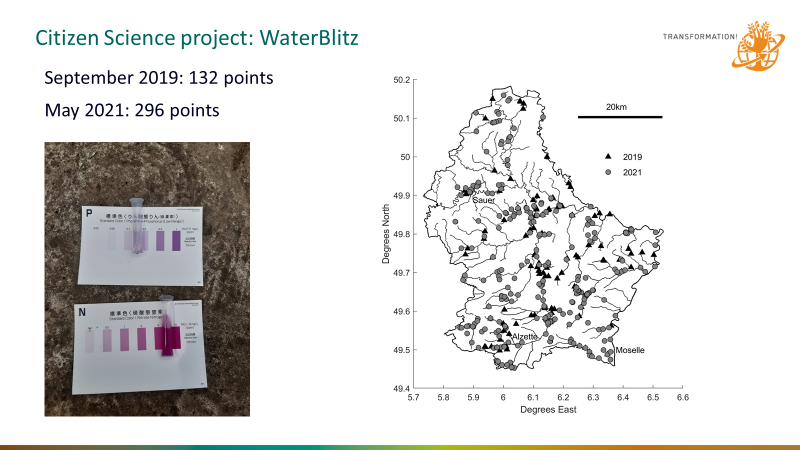
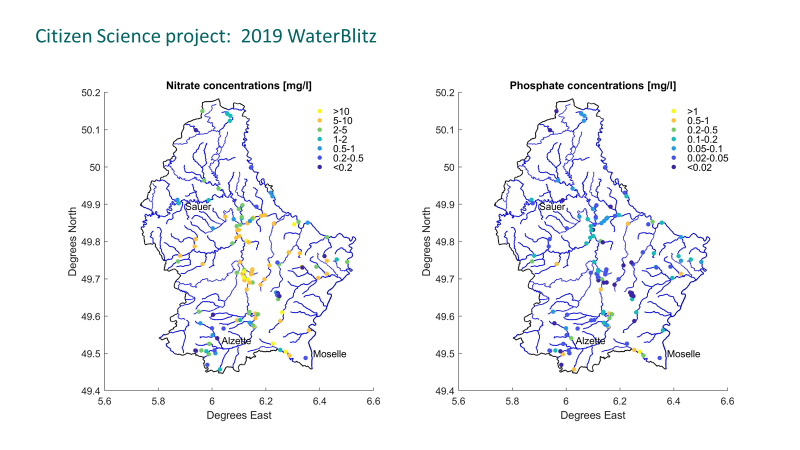
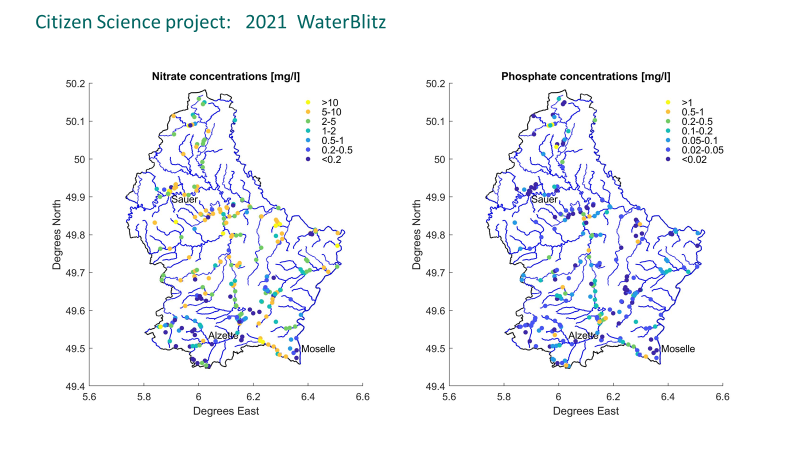
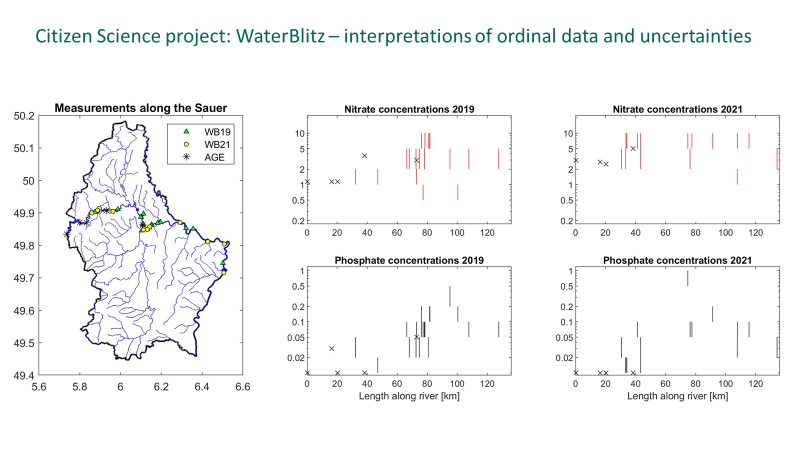
The nutrient concentration data, collected in the intervals, need to be understood as ordinal data. Categories can be ordered, but not compared. Using the guidelines for nitrate concentration to be below 5.7 mg/l for the water body to be classifies as “good”, the highest two nitrate concentration intervals could thus be classified as high concentration intervals.
Citizen Science datasets are characterized by specific uncertainties across a range of different dimensions ranging from adherence to sampling protocols, interpretations of colorimetric assays, with an untrained eye and potential mistakes in entering the data in the app. In our team we recommend quality control and expert review of collected data points. For volunteer groups that commit to recurrent data collection, training workshops are advisable. It is a very common, yet very damaging illusion, that high uncertainty in science entails low quality. The key to quality being skilled management, not elimination, of uncertainty.
Furthermore, the quality of data sets is from sporadic sampling that can be achieved with such ad hoc campaigns. It cannot be compared to data collected in rigorously planned and executed official data collection campaigns that are part of national monitoring programs instituted in compliance to the EU water framework directive. These campaigns however were positively surprising in how well spread sampling sites were across the country, and that they included a fair number of smaller streams, including important sites of aquatic biodiversity. Whilst the WFD (Water Framework Directive) mandates sampling of larger water bodies, ecosystems with particularly high biodiversity are also often found in smaller streams and ponds.
The data collected during the WaterBlitz events clearly provides valuable insight into smaller water bodies and gives indications of potential hotspots with elevated nutrient levels in sites, which are not usually sampled in official programs. Noteworthy examples included the Gander River: From the 10 readings sampling it, 3 recorded nitrate concentration in the highest available interval, >10 mg/l, and 5 further ones in the 5-10 mg/l interval. Also, some of the highest phosphate concentrations. In the Muellerthal Region: In an area about 10km across, 4 readings of nitrate above 10 mg/l and 8 between 5-10 mg/l were observed, with just 3 readings in other intervals.
Moreover, simple observations that may be documented with photographs may give important clues and warnings on possible sources of pollution in surface waters, such as drainage pipes, old or leaky containers for chemicals.
The onset of the pandemic and the start of the Lock-Down in March 2020 coincided with a critical phase of the Ph.D.’s research. Several planned collaborative participatory events had to be cancelled. The Ph.D. candidate experienced the dissertation writing process in such isolation as difficult. The quality of the output did not match quality of prior work of the candidate, due to the lack of social interaction (despite frequent WebEx meetings and chapter commentaries in the critical writing periods).
Nevertheless, most of the main research hypotheses were tested and most of the initial objectives were achieved. However, as the finalization of the definition of the indicators during the pandemic and implementation of the tool took longer than expected we could not proceed to develop exact guidance on how to institute a quality-assured scientific inquiry process, in which citizen volunteers, scientists, policy makers, administrators and private sector water users play a role. The literature review in the Ph.D. thesis as well as the two papers (one published and one close to submission) do however elaborate on the issue of quality assurance in more detail. We could not assess the use or learning of our tool, but instead worked with a suitable place holder of the Earthwatch tool.
In sum, from these first experiments with environmental citizen science for water governance in Luxembourg we addressed a set of three pragmatic research questions as follows:
-
Can volunteers be engaged to get any data at all?
Yes: Water Blitz, corporate programmes show very promising results.
-
What are issues with data quality?
Quality control by professional scientists is required. Large amounts data are required as they are ordinal.
-
Who can and will use this data – for what purpose?
Citizen science data can provide a useful complement official data when sampling rates are low, and it can flag potential pollution hotspots. (https://sustainabilityscience.uni.lu/nexus-futures_/citizen-science/)
We also concluded that it is more difficult to engage volunteers in more time intensive co-creative projects and co-design workshops. These activities were largely of interest to professionals working in related roles in NGOs or water management or engaged on environmental committees of municipalities. Both contributory and co-creative citizen science approaches have a place in fostering public engagement in water governance.
In general, our research including the survey of participants in the WaterBlitz supports that non expert citizen can become more meaningfully engaged when they are empowered and equipped to collect data about their own environment. Advantages for public engagement in governance thus include that citizen can:
- Gain own experience: Civilians come to understand the nature of scientific knowledge, the meaning of data (validity & reliability) better when actively engaged in scientific inquiry
- Build own local capacities and expertise: Civilians discover how easy and quickly one can become an expert in a specific issue in their own local environment
- Access without great costs: Access to cheap ICT (information and communications technology) with enormous monitoring and storing capacity makes ‘doing science’ easier and more affordable
- Learn to assess and evaluate dynamic complexity of environmental processes: Monitoring social, technological and environmental change in parallel for reflection about complex systems and how to better act upon them is in reach now
- Gain awareness of consequences of own actions (household contributions) by self-monitoring the impact of one’s own actions, one can become more reflexive and effective in bringing about change
The reference group has decided that individual free use of the app should be limited exclusively to collecting observations, even in data collection campaigns. Accordingly, the WasserLux app will be set up with a button at the very top that differentiates between free observations and measurements (this has already been clarified with the programmer). The observations that can be documented by the app are supplemented accordingly by the parameters of the disturbance factor analysis at the Syr. These factors also provide a basis for analyses based on the beam effect concept. Further preliminary work on the visual survey by non-experts of relevant information on structures by German researchers is also being considered here (Meier et al. 2011).
An app, which serves to collect the disturbance factors and easily visible structural parameters of stream impact models, can then potentially be used by all river partnerships to create a comparable mapping of the different river basins on a website.
The adaptation of the app for this purpose has been in progress since the reference group meeting with the programmers in June 2022. A draft is being coordinated with Alexandra Arendt and Stephan Müllenborn (River Partnership Syr) and Nora Wellschbillig (AGE).
The supplementation of observations with quantitative surveys using toolsets (e.g., Secchi Tube for turbidity/sediment content determinations and test kits for chemical substances) should only be carried out by appropriately trained persons who have taken part in train-the-trainer workshops at the university or workshops run by appropriately trained trainers. If the button 'Measurement' is clicked, a field should appear in which a number for the identification of the test kit is entered and/or automatically generated, so that later, through additional documentation, a clear assignment is possible as to which type of test kit was used at the location. We will organize a joint data collection event with all interested parties after the summer for the inauguration of the app.
A simple didactically prepared toolkit for teachers and students and guided walks in nature parks and exhibitions will be developed before March 2023. This will include instructions for conducting chemical analyses, standard operating procedures, and details of where and which appropriate strips and reagents can be ordered online. Instructions for quantitative surveys will be developed with Jo Hansen and his laboratory manager. Instructions will promote surveys that may reveal incidents with sewage treatment plants (e.g., by determining ammonium concentrations).
A simple didactically prepared toolkit for teachers and students and guided walks in nature parks and exhibitions will be developed before March 2023. This will include instructions for conducting chemical analyses, standard operating procedures, and details of where and which appropriate strips and reagents can be ordered online. Instructions for quantitative surveys will be developed with Jo Hansen and his laboratory manager. Instructions will promote surveys that may reveal incidents with sewage treatment plants (e.g., by determining ammonium concentrations).
The encouraging outcomes of the citizen science project strengthened our resolve to dedicate the next 10 to 15 years to further facilitating the establishment of innovative structures and practices for evidence-based learning for the regeneration of the life support system through place-based actions and policies in cross-scale participatory processes including with citizen science approaches. We will extend these activities internationally with our network of partners. The ministerial support for a five-year follow-up project on drought resilience with a citizen science-based early warning system has just been secured. The citizen science approach that emerged from this project is one of several pillars of our national Transformation Lab that we will launch with our partners in government and NGOs in the summer of 2022 (https://transformation-lab.lu/?ucp-access=ea7f3880).
A five-year follow-up project with a focus on drought resilience with a citizen science-based early warning system has just been secured.
Partners and Collaboration
River Partnership Syr
Lorem Ipsum is simply dummy text of the printing and typesetting industry. Lorem Ipsum has been the industry's standard dummy text ever since the 1500s, when an unknown printer took a galley of type and scrambled it to make a type specimen book.
River Partnership Obersauer
Lorem Ipsum is simply dummy text of the printing and typesetting industry. Lorem Ipsum has been the industry's standard dummy text ever since the 1500s, when an unknown printer took a galley of type and scrambled it to make a type specimen book.
L’Administration de la gestion de l'eau (AGE)
Lorem Ipsum is simply dummy text of the printing and typesetting industry. Lorem Ipsum has been the industry's standard dummy text ever since the 1500s, when an unknown printer took a galley of type and scrambled it to make a type specimen book.
Ministry of the Environment, Climate and Sustainable Development
Lorem Ipsum is simply dummy text of the printing and typesetting industry. Lorem Ipsum has been the industry's standard dummy text ever since the 1500s, when an unknown printer took a galley of type and scrambled it to make a type specimen book.
Transformation Lab
Lorem Ipsum is simply dummy text of the printing and typesetting industry. Lorem Ipsum has been the industry's standard dummy text ever since the 1500s, when an unknown printer took a galley of type and scrambled it to make a type specimen book.
This website uses no external trackers, no analytics, just session cookies and values your online privacy.



